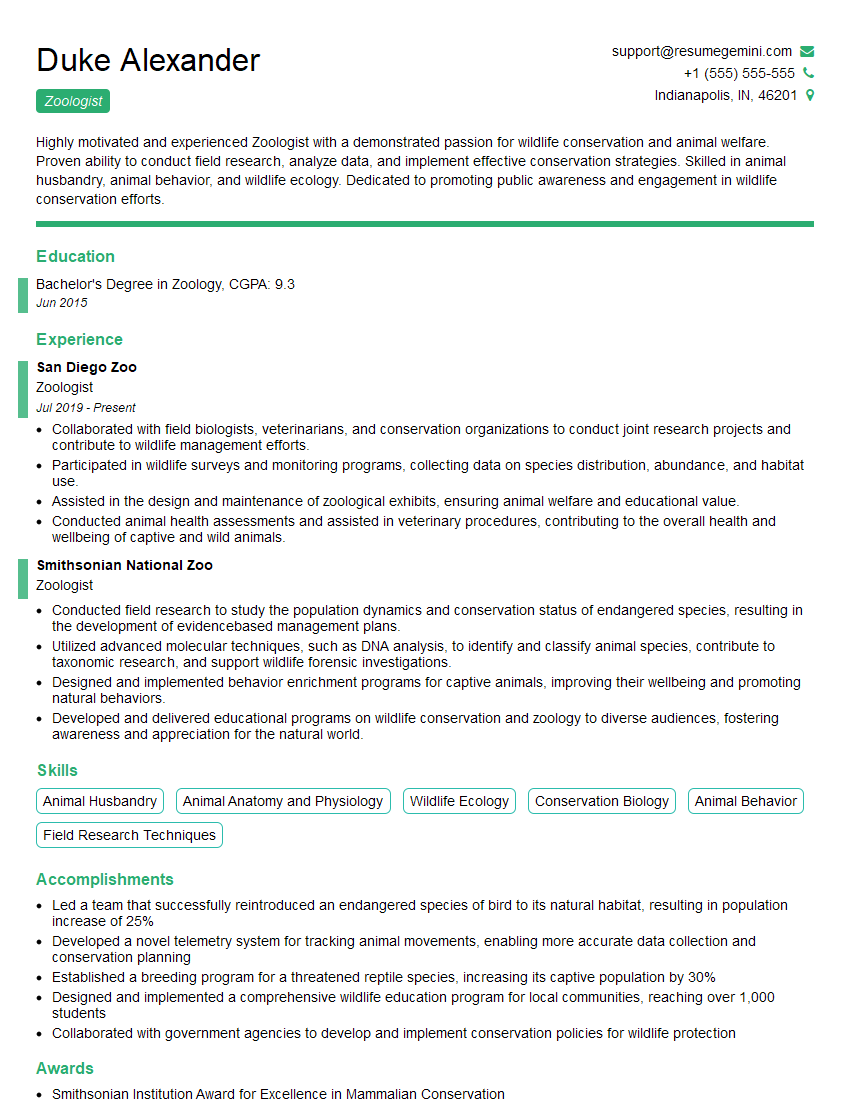The right preparation can turn an interview into an opportunity to showcase your expertise. This guide to Wildlife Biology and Ecology interview questions is your ultimate resource, providing key insights and tips to help you ace your responses and stand out as a top candidate.
Questions Asked in Wildlife Biology and Ecology Interview
Q 1. Explain the difference between a population and a community in an ecological context.
In ecology, population and community represent different levels of biological organization. A population refers to a group of individuals of the same species occupying a particular geographic area and interacting with each other. Think of it like a family reunion – all attendees are related (same species) and share the same space. A community, on the other hand, encompasses all the populations of different species living and interacting within a specific environment. This is like a bustling town square, where many families (populations) from diverse backgrounds (different species) come together, influencing each other’s lives. The key difference lies in the scope: population focuses on a single species, while community encompasses multiple interacting species.
For example, a population might be all the grey wolves in Yellowstone National Park, while the community would include those wolves, along with elk, bison, beavers, various plants, and all other organisms in the park.
Q 2. Describe the concept of carrying capacity and its limitations.
Carrying capacity is the maximum population size of a biological species that can be sustained indefinitely by a given environment, considering the food, habitat, water, and other necessities available. Imagine it as the number of people a lifeboat can safely hold – exceeding that number leads to problems. It’s a dynamic concept, not a fixed number, as environmental conditions (e.g., rainfall, food availability) constantly fluctuate.
Limitations of the carrying capacity concept include:
- Difficulty in precise measurement: Accurately determining carrying capacity is challenging because it requires understanding all limiting factors and how they interact, which can be very complex.
- Variations in resource availability: Carrying capacity isn’t constant; it fluctuates based on seasonal changes, disease outbreaks, or other disturbances. A population might temporarily exceed carrying capacity during a period of high resource availability, only to crash later when resources diminish.
- Oversimplification of interactions: The concept often simplifies complex species interactions, such as predation, competition, and symbiosis, which can significantly impact population size.
- Ignoring the impact of human activities: Human activities like habitat destruction, pollution, and climate change can drastically alter carrying capacity, often lowering it.
For instance, the carrying capacity of deer in a forest might decrease if a significant portion of the forest is cut down, reducing the available food and shelter.
Q 3. What are the key threats to biodiversity, and how can they be mitigated?
Biodiversity, the variety of life at all levels, faces numerous threats. The key threats are:
- Habitat loss and fragmentation: Destruction and division of natural habitats are the biggest drivers of biodiversity loss. Think of it like destroying a city’s parks and dividing the remaining green spaces with roads – wildlife loses essential resources and connectivity.
- Climate change: Altered temperature patterns, precipitation changes, and extreme weather events disrupt ecosystems and force species to adapt or migrate, often failing at both.
- Pollution: Air, water, and soil pollution poison ecosystems and harm organisms directly or indirectly, affecting their survival and reproduction.
- Overexploitation: Overfishing, hunting, and poaching deplete wildlife populations faster than they can recover, threatening species with extinction.
- Invasive species: Non-native species introduced into new environments can outcompete native species, disrupt ecological processes, and even cause extinctions.
Mitigation strategies involve a multi-pronged approach:
- Protected areas: Establishing national parks and reserves to safeguard crucial habitats.
- Sustainable resource management: Implementing practices that ensure resource use doesn’t deplete populations below sustainable levels.
- Pollution control: Implementing regulations and technologies to reduce pollution.
- Combating invasive species: Developing strategies to prevent the introduction and spread of invasive species.
- Climate change mitigation and adaptation: Reducing greenhouse gas emissions and helping species adapt to changing conditions.
For example, reforestation efforts help restore habitats, while implementing sustainable fishing practices protects fish populations.
Q 4. Explain the principles of habitat restoration and give a practical example.
Habitat restoration aims to recover degraded or destroyed ecosystems to their former ecological function and structure. It’s like fixing a broken clock – you’re trying to bring back its functionality. The principles involve:
- Identifying the degradation: Determining the causes and extent of habitat damage.
- Setting restoration goals: Defining what constitutes successful restoration (e.g., species composition, ecosystem processes).
- Developing a restoration plan: Outlining specific actions required to achieve goals.
- Implementing actions: Carrying out tasks like removing invasive species, replanting native vegetation, or restoring hydrology.
- Monitoring and evaluation: Tracking the progress of restoration and adapting the plan as needed.
Practical example: The restoration of wetlands after agricultural drainage. This involves removing drainage ditches, re-contouring the land to encourage water retention, and replanting native wetland vegetation. Monitoring involves assessing water quality, plant species diversity, and the return of wetland-dependent wildlife.
Q 5. Discuss different wildlife population monitoring techniques and their advantages/disadvantages.
Wildlife population monitoring uses various techniques, each with advantages and disadvantages:
- Census: Counting every individual in a population. Advantage: Provides the most accurate estimate. Disadvantage: Extremely time-consuming and often impractical for large or mobile populations.
- Mark-recapture: Marking a sample of individuals, releasing them, and then capturing another sample to estimate the total population size. Advantage: Useful for mobile populations. Disadvantage: Assumes equal catchability of marked and unmarked animals, and handling may stress animals.
- Distance sampling: Observing animals along transects and estimating abundance based on the distances of sighted animals. Advantage: Less invasive than mark-recapture. Disadvantage: Detection probability must be considered, affecting accuracy.
- Index methods: Using indirect indicators of population size, such as scat counts or vocalization surveys. Advantage: Relatively inexpensive and less time-consuming. Disadvantage: Provides only relative estimates; not absolute population size.
- Camera trapping: Using motion-activated cameras to record wildlife activity. Advantage: Provides detailed information on species presence, abundance, and behavior. Disadvantage: Camera placement is crucial for accurate results.
The choice of technique depends on the species, habitat, research questions, and available resources.
Q 6. How do you analyze wildlife data using statistical methods?
Analyzing wildlife data involves applying various statistical methods depending on the research question and data type. Common techniques include:
- Descriptive statistics: Summarizing data using measures like mean, median, standard deviation, and frequency distributions to describe basic population characteristics.
- Population estimation: Using mark-recapture, distance sampling, or other models to estimate population size and density.
- Survival analysis: Analyzing time-to-event data (e.g., survival times) to understand factors affecting mortality.
- Regression analysis: Investigating relationships between variables, such as the relationship between population size and environmental factors.
- Generalized linear models (GLMs): Modeling non-normal data (e.g., count data) to examine factors influencing population abundance or distribution.
- Spatial analysis: Using GIS software to analyze spatial patterns in wildlife distribution and habitat use.
Software packages like R and SAS are commonly used for these analyses. The selection of appropriate statistical methods is essential for accurate and reliable interpretation of wildlife data.
Q 7. Describe your experience with GIS software in wildlife research or management.
I have extensive experience using GIS software (primarily ArcGIS and QGIS) in wildlife research and management. I’ve used GIS for various applications, including:
- Habitat mapping: Creating habitat maps based on satellite imagery, aerial photography, and field data to identify suitable habitat for different species.
- Species distribution modeling: Predicting the spatial distribution of species based on environmental variables using software like MaxEnt.
- Spatial analysis of movement data: Analyzing GPS tracking data to understand animal movements, home range size, and habitat use patterns.
- Network analysis: Analyzing connectivity among habitat patches to identify critical corridors and barriers to movement.
- Planning conservation interventions: Using GIS to identify priority areas for conservation actions, such as habitat restoration or protected area establishment.
For example, in a recent project, I used ArcGIS to map the distribution of an endangered bird species, integrating data on vegetation cover, elevation, and human land use to identify critical habitats and prioritize conservation efforts. My proficiency in GIS allows me to visualize, analyze, and interpret spatial data effectively, improving the accuracy and relevance of wildlife research and management plans.
Q 8. Explain the concept of trophic levels and energy flow within an ecosystem.
Trophic levels describe the hierarchical levels in a food web, representing the organism’s position in the energy flow. Energy flows through an ecosystem from producers (plants) to consumers (animals) and decomposers. Each level loses energy as heat, meaning less energy is available at higher trophic levels.
Imagine a simple ecosystem: plants (producers) are consumed by herbivores (primary consumers), who are then eaten by carnivores (secondary consumers). Decomposers, like bacteria and fungi, break down dead organisms at each level, returning nutrients to the soil. A significant portion of energy is lost at each transfer; only about 10% of the energy from one level makes it to the next – this is often referred to as the 10% rule. For example, if a plant has 1000 energy units, a herbivore eating that plant might only gain 100 units, and a carnivore eating that herbivore might only gain 10 units. This explains why there are fewer top predators than primary producers in an ecosystem.
- Producers: Plants that capture solar energy through photosynthesis.
- Primary Consumers: Herbivores that eat plants.
- Secondary Consumers: Carnivores that eat herbivores.
- Tertiary Consumers: Top carnivores that eat other carnivores.
- Decomposers: Organisms that break down dead organic matter, recycling nutrients back to the ecosystem.
Q 9. What are the ethical considerations in wildlife research and management?
Ethical considerations in wildlife research and management are paramount. They involve minimizing harm to animals, respecting their welfare, and ensuring the research is conducted responsibly and transparently. Key aspects include:
- Animal welfare: Minimizing stress, pain, and suffering through appropriate handling, anesthesia, and humane euthanasia when necessary. Research protocols must be reviewed and approved by ethical review boards.
- Data integrity and transparency: Honest reporting of findings, acknowledging limitations, and avoiding any bias that could compromise the results. Data should be publicly accessible (where appropriate) and methods should be reproducible.
- Social and cultural considerations: Engaging with local communities and respecting indigenous knowledge and rights when conducting research in their territories. This includes obtaining informed consent and ensuring the research benefits local people.
- Conservation implications: Ensuring that research contributes to effective conservation strategies and avoids unintended negative impacts on wildlife populations. For example, introducing a new management technique must be carefully evaluated to avoid harmful consequences.
- Permitting and regulations: Adhering to all relevant national and international laws and regulations regarding wildlife research and management.
For example, when studying a rare bird species, researchers must use non-invasive methods like camera trapping to avoid disturbing the birds and their habitats. If capture is necessary, it needs to be done humanely with appropriate permits and minimizing the time of handling.
Q 10. How do you design a field study to investigate a specific ecological question?
Designing a field study begins with formulating a clear ecological question. This involves identifying the variables, choosing appropriate study sites, selecting sampling methods, and developing a robust statistical analysis plan.
- Define the question: What specific ecological process or pattern do you want to investigate? (e.g., How does habitat fragmentation affect the diversity of bird species?)
- Formulate hypotheses: Develop testable predictions based on your question. (e.g., Habitat fragmentation will lead to lower bird species diversity).
- Select study sites: Choose sites that represent the range of conditions relevant to your question. This might involve selecting fragmented and continuous forest areas for the bird study.
- Choose sampling methods: Select methods appropriate for your question and study organisms (e.g., point counts, transects, camera trapping for the bird study). Consider the scale of your study.
- Data collection: Collect data systematically and consistently, ensuring accuracy and precision. This includes recording relevant environmental factors.
- Data analysis: Use appropriate statistical methods to analyze your data and test your hypotheses. For instance, statistical tests comparing species diversity between fragmented and continuous forests could be performed.
- Interpretation and communication: Interpret your results in the context of your initial question and existing ecological literature. Clearly communicate your findings in a scientific report or publication.
Q 11. Describe your experience with capture-mark-recapture methods.
Capture-mark-recapture (CMR) is a powerful technique used to estimate population size and other demographic parameters. It involves capturing, marking, and releasing individuals, then recapturing them at a later time. The number of marked individuals in the recapture sample provides information about the overall population size.
My experience includes using various marking techniques – such as tagging, ear notching, and pit tagging – depending on the species. For example, I’ve used radio telemetry and GPS collars to track large mammals, allowing for detailed movement analysis. Analyzing the data involves using models like the Lincoln-Petersen or Jolly-Seber models. These models account for factors like mortality and emigration.
For example, I’ve used CMR to estimate the population size of a threatened reptile species in a fragmented habitat. We used pit tags to identify individual reptiles, allowing us to track their movements and survival rates over several years. The Jolly-Seber model, which accommodates variable capture probabilities and mortality, was employed to analyze the CMR data.
Q 12. Explain the importance of species-area curves in conservation.
Species-area curves describe the relationship between the area of a habitat and the number of species it supports. Larger areas generally support more species due to increased habitat diversity and reduced extinction rates. The shape of the curve can provide insights into the biodiversity of a region and its vulnerability to habitat loss.
In conservation, these curves are crucial for predicting the loss of species when habitats are reduced or fragmented. They allow us to estimate the minimum area required to maintain a certain number of species, informing reserve design and protected area management. For instance, if we know a particular species-area relationship for a region’s bird community, we can estimate how many species might be lost with the destruction of 50% of their habitat.
Conservationists use species-area relationships to inform decisions about habitat protection and restoration. For example, when designing a new nature reserve, understanding the species-area relationship for the region can help determine the minimum size required to conserve a target number of species.
Q 13. Discuss the impact of climate change on wildlife populations.
Climate change poses a significant threat to wildlife populations worldwide. Changes in temperature, precipitation patterns, and extreme weather events can alter habitats, disrupt species interactions, and shift species distributions.
- Habitat loss and alteration: Rising sea levels, increased frequency of wildfires, and shifts in vegetation zones can destroy or alter habitats, making them unsuitable for certain species.
- Range shifts: Many species are shifting their geographic ranges in response to changing climates, leading to potential conflicts with existing species and habitat limitations.
- Phenological mismatches: Changes in the timing of seasonal events (e.g., migration, breeding) can disrupt interactions between species, such as pollinators and their plants, leading to reduced reproductive success.
- Increased stress and disease: Warmer temperatures can increase the prevalence of diseases and parasites, weakening populations and making them more susceptible to other stressors.
- Extinction risk: Many species face an increased risk of extinction due to climate change because they cannot adapt quickly enough or migrate to suitable habitats.
For example, coral bleaching events, caused by rising ocean temperatures, are devastating coral reefs, threatening numerous marine species that depend on these habitats. Similarly, changes in the timing of flowering and insect emergence can disrupt pollination relationships, affecting plant reproduction and plant-eating insect populations.
Q 14. What are invasive species, and what are the methods for their control?
Invasive species are non-native organisms that establish themselves in a new environment and cause ecological and/or economic harm. Their introduction can disrupt native ecosystems by competing with native species for resources, introducing diseases, or altering habitats.
Control methods vary depending on the species and the environment. They can include:
- Physical removal: Manually removing or trapping invasive species, often effective for smaller populations or easily accessible areas.
- Chemical control: Using herbicides, pesticides, or other chemicals to kill invasive species. This method requires careful consideration of non-target effects.
- Biological control: Introducing natural enemies (predators, parasites, or pathogens) of the invasive species. This approach requires rigorous testing to avoid unintended consequences.
- Integrated pest management (IPM): A holistic approach that combines several control methods to effectively manage invasive species while minimizing negative impacts on the environment.
- Habitat restoration: Restoring native habitats can help reduce the establishment and spread of invasive species.
For example, the control of invasive lionfish in the Caribbean Sea has involved a combination of methods, including spearfishing, trapping, and public awareness campaigns to educate divers about the problem. The successful eradication of invasive species usually requires a multifaceted, long-term approach that accounts for the specific characteristics of the invasive species and the ecosystem it invades.
Q 15. Explain the concept of metapopulations and their relevance to conservation.
A metapopulation is a group of spatially separated populations of the same species that interact through the dispersal of individuals. Think of it like a network of smaller populations, each inhabiting its own patch of suitable habitat. These patches are connected by corridors, which allow movement between patches. Some patches might be occupied, while others might be unoccupied but suitable for colonization. The overall persistence of the metapopulation depends on the balance between local extinction in individual patches and recolonization from other occupied patches.
In conservation, understanding metapopulations is crucial because it highlights the importance of habitat connectivity. Protecting not only individual populations but also the corridors connecting them is vital for long-term survival. For example, if we only conserve a single large population of a species, it’s vulnerable to catastrophic events like disease outbreaks or habitat loss. A metapopulation approach, on the other hand, distributes the risk, increasing the resilience of the species as a whole. Effective conservation strategies often involve restoring degraded habitats to improve connectivity between patches and managing the entire metapopulation rather than isolated fragments.
Career Expert Tips:
- Ace those interviews! Prepare effectively by reviewing the Top 50 Most Common Interview Questions on ResumeGemini.
- Navigate your job search with confidence! Explore a wide range of Career Tips on ResumeGemini. Learn about common challenges and recommendations to overcome them.
- Craft the perfect resume! Master the Art of Resume Writing with ResumeGemini’s guide. Showcase your unique qualifications and achievements effectively.
- Don’t miss out on holiday savings! Build your dream resume with ResumeGemini’s ATS optimized templates.
Q 16. Describe your experience with different wildlife survey methods (e.g., line transects, camera trapping).
My experience encompasses a wide range of wildlife survey methods. I’ve extensively used line transects, which involve walking along predetermined lines and recording the sightings of animals. This method is particularly useful for estimating abundance, particularly for animals that are relatively easy to detect. Analysis involves accounting for detection probability to adjust for animals missed. For instance, I used line transects to estimate the population density of mountain goats in a remote alpine region.
Camera trapping is another vital tool in my arsenal. By strategically placing motion-activated cameras in various locations, I can obtain data on species presence/absence, relative abundance, behavior, and even individual identification (through photo-identification). This technique is less disruptive to the animals than direct observation and is especially suitable for elusive or nocturnal species. For instance, I’ve used camera traps extensively to study jaguar populations, observing their activity patterns and habitat use. I am proficient in analyzing the data generated by these cameras and using software to calculate species richness, abundance, and occupancy rates. Other methods I’ve employed include mark-recapture studies, scat surveys, and acoustic monitoring, each tailored to the specific species and research question.
Q 17. How do you assess the health of a wildlife population?
Assessing wildlife population health is multifaceted and requires considering several factors. A holistic approach is essential. We start by evaluating the population’s size and density using methods like mark-recapture or line transects, looking for trends over time. Next, we assess body condition, often using body mass index or other morphometric measures, which helps us understand the nutritional status of the individuals. This can be supplemented by analyzing physiological indicators like blood samples for evidence of disease or malnutrition.
Disease surveillance is a critical aspect, involving testing for common pathogens and parasites. Genetic diversity analysis helps to determine if the population is genetically healthy and capable of adapting to environmental changes. Finally, we also consider behavioral indicators – if animals exhibit unusual behavior like lethargy or avoidance of typical habitats, it could signal underlying health issues. A decline in reproductive rate is another key indicator. Combining these different data points paints a complete picture of the population’s overall health, allowing us to identify potential threats and implement targeted conservation actions.
Q 18. What are the key principles of wildlife disease management?
Wildlife disease management is a complex field, and its principles are built on a multi-pronged strategy. The first principle is surveillance and early detection. Regular monitoring of wildlife populations for diseases is vital to identify outbreaks promptly. Rapid response is crucial – once a disease outbreak is confirmed, swift action to contain the spread is necessary. This often involves quarantining affected areas, culling severely affected animals in some cases, and treating individual animals when feasible.
Prevention is equally important; this might include vaccination programs or managing habitat to reduce the risk of disease transmission. For example, reducing the density of animals in a given area to lessen the spread of pathogens. Furthermore, understanding disease ecology is crucial, which involves investigating factors that influence disease transmission, such as habitat quality, host-pathogen interactions, and environmental stressors. Lastly, effective communication and collaboration among stakeholders are essential for successful disease management. This includes engaging with government agencies, land managers, veterinarians, and local communities. A proactive and integrated approach to wildlife disease management is crucial to protect both wildlife populations and human health.
Q 19. Explain the concept of ecological succession.
Ecological succession describes the gradual change in species composition and community structure over time within an ecosystem. Imagine a bare rock after a volcanic eruption: initially, only hardy pioneer species like lichens and mosses can survive. These organisms slowly break down the rock, creating a layer of soil, enabling more complex plant species to establish themselves. As the community develops, it goes through various stages, with each stage being replaced by another until a relatively stable climax community is reached.
There are two main types: primary succession, which starts from a completely barren habitat like the bare rock example, and secondary succession, which occurs in areas where a pre-existing community has been disturbed, such as after a forest fire. Succession is not always a linear process; it can be influenced by various factors like climate, disturbances, and the interactions between species. Understanding ecological succession is critical in habitat restoration and conservation efforts, helping us predict how ecosystems will recover from disturbances and guide management practices to accelerate the process towards a desired community state.
Q 20. Describe different types of wildlife habitats and their characteristics.
Wildlife habitats are incredibly diverse, each characterized by specific environmental conditions that support particular species. Forests, for instance, provide cover, food, and nesting sites for a wide range of animals. Different forest types, such as temperate deciduous forests or tropical rainforests, have distinct structures and species assemblages. Grasslands, characterized by dominant grasses and herbaceous plants, support grazing animals and other species adapted to open habitats.
Wetlands, including swamps, marshes, and bogs, are crucial habitats known for their high biodiversity and water-dependent species. Aquatic habitats, such as rivers, lakes, and oceans, host a wealth of aquatic life. Deserts, with their arid conditions, have specialized flora and fauna adapted to water scarcity. Each habitat type has unique characteristics that influence the distribution and abundance of wildlife; factors like temperature, rainfall, soil type, and vegetation structure all play significant roles. Understanding these differences is fundamental to effective wildlife management and conservation.
Q 21. How do you use remote sensing data for wildlife monitoring?
Remote sensing data, obtained from satellites or airborne sensors, is a powerful tool for wildlife monitoring, particularly over large spatial scales. Satellite imagery, for example, can be used to map habitat types and changes in land cover over time. This helps us understand habitat fragmentation, degradation, and the availability of resources for wildlife. Higher resolution imagery can even be used to detect individual animals or their signs, such as footprints or burrows.
Another application is through thermal infrared sensors, which can detect animal body heat, enabling the detection of animals even under dense vegetation cover. Data from LiDAR (Light Detection and Ranging) can be used to create detailed three-dimensional models of the landscape, which helps us understand habitat structure and its suitability for different species. The data is analyzed using Geographic Information Systems (GIS) software to create maps and overlays, allowing for detailed assessments of habitat quality and wildlife distribution. Remote sensing provides a non-invasive, cost-effective, and efficient way to monitor wildlife populations and their habitats over vast areas.
Q 22. What is your experience with wildlife telemetry and data analysis?
My experience with wildlife telemetry and data analysis is extensive. I’ve worked with various tracking technologies, from VHF radio collars to GPS and satellite transmitters, deploying them on a wide range of species, including large mammals like elk and bears, and smaller animals like birds and reptiles. Data analysis involves using statistical software packages like R and ArcGIS to process location data, assess animal movements, habitat use, and home range size. For example, in a recent project studying the migration patterns of the endangered Whooping Crane, I used GPS data to identify crucial stopover sites along their migratory route, helping inform conservation strategies.
Beyond basic location data, I’m proficient in analyzing data from accelerometer and temperature sensors integrated into telemetry devices to understand animal behavior and physiological responses to environmental changes. For instance, analyzing accelerometer data helped us determine the foraging efficiency of a seal population during different seasons.
My analysis often involves exploring spatial relationships using Geographic Information Systems (GIS), integrating telemetry data with environmental variables like vegetation cover, elevation, and human disturbance levels to understand habitat selection and movement patterns. This allows for evidence-based predictions of animal behavior under changing environmental conditions.
Q 23. Explain the concept of keystone species and their role in the ecosystem.
A keystone species is a species whose presence and role within an ecosystem has a disproportionately large impact on its overall structure and function. Think of it like a keystone in an archway – remove it, and the whole structure collapses. These species are not necessarily the most abundant, but their interactions with other species are crucial for maintaining biodiversity.
For example, sea otters are considered a keystone species in kelp forests. They prey on sea urchins, which are voracious consumers of kelp. Without sea otters, sea urchin populations explode, leading to the destruction of kelp forests and the loss of habitat for countless other species. The impact extends beyond the immediate predator-prey relationship, influencing the entire ecosystem’s health and stability.
Similarly, certain plant species can act as keystone species by providing critical habitat or food resources for a wide array of animals. A large tree in a savanna might provide nesting sites for birds, shelter for small mammals, and food for insects, all interconnected within a complex web of life. The loss of such a keystone species could trigger a cascade of negative impacts on biodiversity.
Q 24. Discuss your experience with writing scientific reports and grant proposals.
Throughout my career, I have extensively engaged in scientific writing, encompassing the preparation of peer-reviewed manuscripts for publication in leading journals like *Conservation Biology* and *Journal of Wildlife Management*, as well as crafting compelling grant proposals for organizations such as the National Science Foundation (NSF) and the Wildlife Conservation Society (WCS).
My approach to scientific writing emphasizes clarity, conciseness, and strong evidence-based arguments. I’m adept at presenting complex ecological data in a way that is accessible and engaging to both scientific and lay audiences. When writing grant proposals, I focus on developing a clear narrative that highlights the significance of the research problem, the innovative methods proposed, and the potential societal impact of the project. I have a proven track record of securing funding for my research projects, demonstrating the effectiveness of my writing.
For example, a successful grant I wrote focused on the use of novel sensor technology to monitor wildlife populations. The grant proposal meticulously described the need for improved population monitoring methods, the technological approach, the analytical plan, and the expected outcomes, leading to successful funding and the completion of the research.
Q 25. What are your thoughts on the use of citizen science in wildlife conservation?
Citizen science offers an invaluable contribution to wildlife conservation by significantly expanding the scope and scale of data collection. By engaging volunteers in monitoring efforts, we can obtain data across vast geographic areas and over extended time periods, something often impossible with limited professional resources. This collaborative approach fosters a sense of stewardship among community members, increasing public awareness and support for conservation efforts.
However, careful consideration must be given to data quality control. Training and standardized protocols are crucial to ensure the reliability of the data gathered. It’s important to also acknowledge the limitations of citizen science, particularly when dealing with complex research questions requiring specialized expertise. A well-structured citizen science project needs a balance between community involvement and scientific rigor to generate meaningful results.
For instance, a successful citizen science project I worked on involved monitoring bird populations across multiple urban parks. Volunteers, trained in bird identification, conducted regular surveys, providing valuable data on species abundance, distribution, and habitat use. This data helped us assess the impact of urbanization on avian diversity and inform urban planning decisions.
Q 26. Describe a successful wildlife conservation project you have been involved in.
One successful conservation project I was deeply involved in focused on restoring habitat for the endangered California Condor. The project combined habitat restoration efforts with captive breeding and reintroduction programs. We worked with land managers to restore crucial foraging habitats by removing invasive species, controlling grazing pressure, and enhancing natural vegetation. This involved extensive fieldwork, coordinating with ranchers and other stakeholders to implement sustainable land management practices.
Simultaneously, we collaborated with a captive breeding facility to successfully release and monitor reintroduced condors, using telemetry to track their movements and assess their survival rates. The project required close monitoring of the birds to ensure they were acquiring sufficient food resources and avoiding human-wildlife conflicts. Through careful planning and collaboration, we saw a significant increase in the wild condor population and an improvement in habitat quality.
This project highlighted the importance of integrating different conservation approaches, from habitat restoration to captive breeding, and the need for strong community involvement to achieve long-term conservation success.
Q 27. How do you handle conflicts between human activities and wildlife?
Handling conflicts between human activities and wildlife requires a multi-faceted approach focused on understanding the root causes of the conflict, mitigating the risks to both humans and wildlife, and fostering collaboration between stakeholders. This often involves identifying areas of overlap between human activities and wildlife movement patterns.
For example, in a situation where a growing human population encroaches upon bear habitat, leading to increased human-bear encounters, conflict mitigation strategies might include educating local communities on proper waste management, installing bear-resistant containers, and promoting non-lethal deterrents like electric fences. It’s crucial to understand the bear’s perspective – their access to food and shelter – and design solutions that address those needs while ensuring human safety.
A crucial component is stakeholder engagement. This includes working closely with local communities, landowners, and government agencies to develop and implement strategies that are both effective and acceptable to all involved. A successful solution requires a balance between protecting wildlife and accommodating human needs.
Q 28. What is your experience working with endangered species?
My work with endangered species has been a significant part of my career. I have participated in various conservation projects focused on species recovery, ranging from the development of species recovery plans to fieldwork involving monitoring populations, assessing habitat suitability, and implementing management actions.
For instance, I was part of a team that developed a conservation plan for the critically endangered Florida Panther. This involved population viability analyses to predict the long-term survival of the species, habitat suitability modeling to identify critical areas for protection, and recommendations for mitigating human-wildlife conflicts. The plan also outlined strategies to promote genetic diversity within the population.
Working with endangered species necessitates a deep understanding of the ecological factors impacting their survival and the development of evidence-based strategies that address the threats they face. It’s imperative to adapt and refine conservation strategies based on scientific monitoring and evaluation.
Key Topics to Learn for Your Wildlife Biology and Ecology Interview
- Population Ecology: Understanding population dynamics, growth models (exponential, logistic), carrying capacity, and factors influencing population size. Practical application: Analyzing population data to inform conservation strategies.
- Community Ecology: Exploring species interactions (competition, predation, symbiosis), niche theory, and community structure. Practical application: Designing and interpreting biodiversity surveys.
- Conservation Biology: Focusing on threatened and endangered species, habitat loss, fragmentation, and the application of ecological principles to conservation management. Practical application: Developing and evaluating conservation plans.
- Wildlife Management: Exploring techniques for managing wildlife populations, including hunting regulations, habitat manipulation, and disease control. Practical application: Designing and implementing wildlife management programs.
- Behavioral Ecology: Understanding animal behavior in relation to their environment, including foraging strategies, mating systems, and social structures. Practical application: Interpreting animal behavior data to inform conservation efforts.
- Research Methods: Mastering data collection techniques (e.g., mark-recapture, camera trapping, GPS tracking), statistical analysis, and scientific writing. Practical application: Designing and executing research projects to answer ecological questions.
- GIS and Remote Sensing: Utilizing Geographic Information Systems and remote sensing technologies for spatial analysis of ecological data. Practical application: Mapping habitat suitability and monitoring wildlife movements.
- Ecological Modeling: Developing and interpreting ecological models to predict future trends and evaluate management scenarios. Practical application: Simulating the impact of climate change on wildlife populations.
Next Steps
Mastering Wildlife Biology and Ecology opens doors to a rewarding career with diverse opportunities in research, conservation, management, and education. A strong foundation in these areas is crucial for securing your dream position. To significantly enhance your job prospects, focus on crafting a compelling and ATS-friendly resume that showcases your skills and experience effectively. ResumeGemini is a trusted resource that can help you build a professional resume tailored to the specific requirements of the Wildlife Biology and Ecology field. Examples of resumes tailored to this field are available to guide you. Take the next step towards your ideal career – create a resume that makes you stand out!
Explore more articles
Users Rating of Our Blogs
Share Your Experience
We value your feedback! Please rate our content and share your thoughts (optional).










